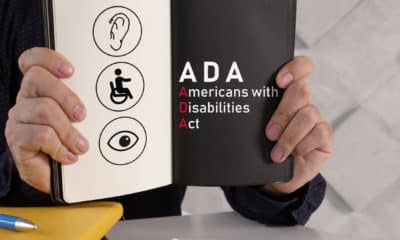In 1998, after five years of task force meetings and long committee sessions, the American National Standards Institute published the new version of ANSI-A117.1, the standards for accessible buildings. In that 1998 standard was what looked like a completely new section on signs. Now, the Access Board has published its proposal for a new set of ADA Accessibility Guidelines, or ADAAG. The sign section is based on the 1998 ANSI standard. If the Department of Justice moves ahead with its adoption, the ADA will have a new look. There are several questions you may want to ask: Will the signs I made earlier be non-compliant now? Will I have to completely change the way I make ADA signs? When should I start playing by the new rules? The answer to the first question is No." If you made a sign system that complied with the current ADAAG, then the building owner will not have to replace that system. However, like all parts of the built environment, if signs need to be replaced, then they should be replaced with signs that follow the new rules, not the old ones. That falls under the "barrier removal" part of the law. The second answer is "That depends." How far did your signs go beyond the minimal rules established by the first set of guidelines? If you did the research and found out how to make signs that could be easily read by touch, then you may already be following most of the new guidelines. The new standards call for tactile characters that are sans serif, with a fairly thin stroke, and that have discernable space between each character. Highly condensed typefaces are out, as are italics. Braille has a rounded profile. Visual characters now must follow a size chart that depends on viewing distance. Most other standards remain the same. Yes, the sign section is much longer than before, but that is mostly a matter of spelling everything out in detail, and separating the various components of a sign into different sections. The answer to the third question lies in the second. Because the new rules seldom conflict in any way with the current ones, you can begin to use almost all of them right now. Even if some of the new rules should be dropped by the Department of Justice — rather unlikely in any case — there still won’t be any reason not to use them. For instance, if the standard requiring rounded Braille dots were dropped, rounded dots would still be far superior and more readable than flat ones. If someone decided to remove the requirement that Braille be placed beneath the tactile characters, it would still be OK, and appreciated by many members of the blindness community, to do so. The present plan is that one more hearing will be held in the Washington area on March 13. Public comments will close on March 15. The Access Board will consider all the testimony, possibly make some changes, and then send the final document on its government rounds. Will it become official by the end of the year 2000? That is anyone’s guess. Your customers, however, can start benefitting from a much improved set of sign standards right now.


 Photo Gallery5 days ago
Photo Gallery5 days ago
 Tip Sheet2 weeks ago
Tip Sheet2 weeks ago
 Ask Signs of the Times7 days ago
Ask Signs of the Times7 days ago
 Paula Fargo2 days ago
Paula Fargo2 days ago
 Real Deal2 weeks ago
Real Deal2 weeks ago
 Benchmarks1 week ago
Benchmarks1 week ago
 Photo Gallery2 days ago
Photo Gallery2 days ago
 Women in Signs2 weeks ago
Women in Signs2 weeks ago







